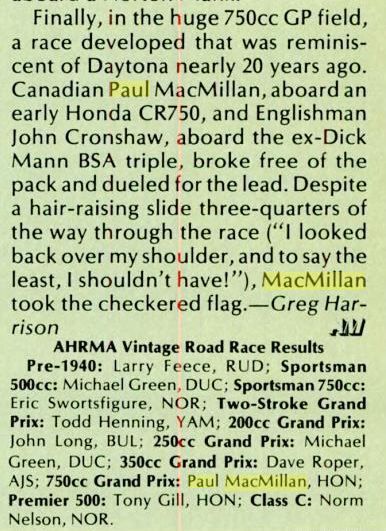bdr529 wrote:
You have a tendency to pick and chose which articles you want to believe, and they all seem to be the ones that favor your opinion.
If you don't like the analogy of the frame being better suited to a moped, and you feel Dave Gurry is full of BS,
then I suggest you write the good people at Classic Motorcycle with your complaint.
What I personally said about the bike having to much power for the frame to handle, is backed up by your link
The author Kevin Cameron called it a "negative quality".." high power is the sworn enemy of good handling"
http://www.kawtriple.com/mraxl/articles/smokin.jpg
http://i65.photobucket.com/albums/h217/ ... gvcc2g.jpg
My opinion of that bike having poor handling came from people "that have both owned and race the H2 triple"
One of those persons was Kawasaki Factory racer Yvon Duhamel
Here's what he said in 1975 about his Kawasaki race bike
“The way the Kawasaki frame is made,” Duhamel said, “or the way the engine is placed or something, something is wrong there. It just wants to lose traction at the rear wheel. It moves six inches and that’s it, it wants to high-side you.”
http://www.cycleworld.com/2010/08/18/fo ... good-year/
It seems even though Kawasaki made great motors they were less competent at making a good chassis
Bdr..., Kevin Cameron of course, built & raced Kaw triples, so he does have hands on experience with them.
As for Yvon Du Hamel, he was referring to the H2R G.P. racing F750 bike, which was under fairly constant development at the time, due to the concurrent issues of having to build a chassis to cope with big power, & very high speeds..
He was trapped at Daytona in `74 doing "298 Km/h", ( according to Cycle Australia magazine), with the tyres of the day - certainly at their limits too, Barry Sheene barely survived a nasty blow-out there, on his heavier Suzuki F750 machine.
Kawasaki did get their F750 racebike good enough to take the lap record at difficult tracks including the I.o.M, & Bathurst..
The H2 roadbike also won the showroom stock production class race at Bathurst.
This means that poorly thought out ideas expressed in retrospective articles by 'classic' magazines don't carry much
weight, rather they often seek to lazily trot out spurious stereotypes, instead of examining the historical record.
Those reports which do feature a current ride by the reporter, will generally tend to debunk the old 'horror'stories.
But bdr... if you choose to 'believe' - such lurid tales - over the real achievements as shown on the historical record,
then I suggest you try a Dave G move & "turn the handle bars at ~40mph" - on any bike & see what will happen..
As I previously noted, these early Nippon superbikes did not feature the fine steering/handling balance of the Norton &
Triumphs, these Brits had the benefit of decades of racing heritage.. & indeed a check of the Kawasaki H series steering specifications shows yearly alterations in the various dimensions of rake/trail/offsets etc, in a real attempt to get it sorted..
Yamaha showed the way with its sporty RD twins, which used a race-developed chassis, but Nippon built big road bikes didn't really start to show meaningful steering finesse until the end of the `70s..
However, road holding, ground clearance & braking were good enough, for the road, & race - even if you had to hold on & force 'em to follow a line.. while they wriggled a bit underneath you.. its still no big deal really.. even if evident as a "negative quality".

